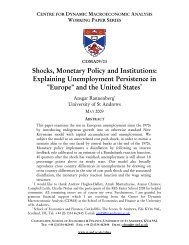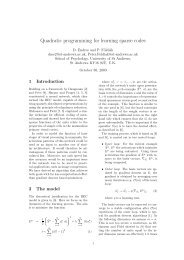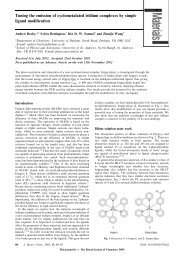Delay and Haircuts in Sovereign Debt - University of St Andrews
Delay and Haircuts in Sovereign Debt - University of St Andrews
Delay and Haircuts in Sovereign Debt - University of St Andrews
Create successful ePaper yourself
Turn your PDF publications into a flip-book with our unique Google optimized e-Paper software.
We beg<strong>in</strong> at t = 2. First, let us consider the case <strong>in</strong> which the debtor is<br />
Optimistic. Let x L <strong>and</strong> x O denote the payo¤s for the Optimistic debtor when<br />
the creditor <strong>and</strong> the Optimistic debtor are the proposers, respectively <strong>and</strong><br />
let x L <strong>and</strong> x O denote the share <strong>of</strong> the available barga<strong>in</strong><strong>in</strong>g surplus for<br />
the creditor when the creditor <strong>and</strong> the Optimistic debtor are the proposer,<br />
respectively. Us<strong>in</strong>g the st<strong>and</strong>ard arguments 20 , to compute the payo¤s for<br />
the creditor <strong>and</strong> the Optimistic debtor, the follow<strong>in</strong>g two equations need to<br />
be solved:<br />
x L = 2 (x L + x O ) ;<br />
(A1)<br />
x O = 2 ( x L + x O ) ; (A2)<br />
where denotes the common discount factor. Equations (A1) <strong>and</strong> (A2) have<br />
a unique solution, given by (x O ; x L ):<br />
x O = 2<br />
<br />
2 <strong>and</strong> x L = 2 : (A3)<br />
Accord<strong>in</strong>g to (A3), at t = 2, if the Optimistic debtor is a proposer, she<br />
o¤ers x O = 2<br />
to the creditor <strong>and</strong> if it is the creditor who is the proposer,<br />
the creditor’s o¤er is x L = 2<br />
. Given that each negotiat<strong>in</strong>g party has an<br />
equal probability <strong>of</strong> be<strong>in</strong>g the proposer, it follows that the expected payo¤s<br />
for the Optimistic debtor <strong>and</strong> the creditor at t = 2 are given by 2 ; 2<br />
<br />
,<br />
respectively.<br />
Next, we consider the case <strong>in</strong> which the debtor is Cautious. The Cautious<br />
debtor has concern about the susta<strong>in</strong>ability <strong>of</strong> any debt settlement. The<br />
presence <strong>of</strong> such susta<strong>in</strong>ability constra<strong>in</strong>t reduces the amount <strong>of</strong> barga<strong>in</strong><strong>in</strong>g<br />
surplus that is available for debt restructur<strong>in</strong>g negotiation from to <br />
Let ~x L <strong>and</strong> ~x C denote the payo¤s for the Cautious debtor when the creditor<br />
<strong>and</strong> the Cautious debtor are the proposers, respectively, <strong>and</strong> let (<br />
~x L <strong>and</strong> ( s) ~x C be the share <strong>of</strong> the available barga<strong>in</strong><strong>in</strong>g surplus for<br />
the creditor when the creditor <strong>and</strong> the Cautious debtor are the proposers,<br />
respectively. Us<strong>in</strong>g the same logic as above, when the Cautious debtor is the<br />
proposer, she always o¤er ( s) ~x ( s)<br />
C<br />
=<br />
2<br />
to the creditor, while, if the<br />
20 Such arguments are as follows. In the equilibrium, either party will agree to a debt<br />
restructur<strong>in</strong>g proposal if the proposal o¤ers the party at least as much <strong>in</strong> discounted<br />
present value term as it can expect to atta<strong>in</strong> by wait<strong>in</strong>g until the next period, given the<br />
strategies <strong>of</strong> both parties.<br />
28<br />
s)<br />
s.
















